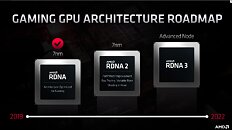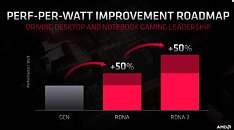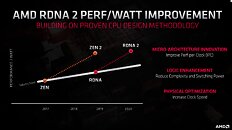Friday, March 6th 2020

AMD RDNA2 Graphics Architecture Detailed, Offers +50% Perf-per-Watt over RDNA
With its 7 nm RDNA architecture that debuted in July 2019, AMD achieved a nearly 50% gain in performance/Watt over the previous "Vega" architecture. At its 2020 Financial Analyst Day event, AMD made a big disclosure: that its upcoming RDNA2 architecture will offer a similar 50% performance/Watt jump over RDNA. The new RDNA2 graphics architecture is expected to leverage 7 nm+ (7 nm EUV), which offers up to 18% transistor-density increase over 7 nm DUV, among other process-level improvements. AMD could tap into this to increase price-performance by serving up more compute units at existing price-points, running at higher clock speeds.
AMD has two key design goals with RDNA2 that helps it close the feature-set gap with NVIDIA: real-time ray-tracing, and variable-rate shading, both of which have been standardized by Microsoft under DirectX 12 DXR and VRS APIs. AMD announced that RDNA2 will feature dedicated ray-tracing hardware on die. On the software side, the hardware will leverage industry-standard DXR 1.1 API. The company is supplying RDNA2 to next-generation game console manufacturers such as Sony and Microsoft, so it's highly likely that AMD's approach to standardized ray-tracing will have more takers than NVIDIA's RTX ecosystem that tops up DXR feature-sets with its own RTX feature-set.Variable-rate shading is another key feature that has been missing on AMD GPUs. The feature allows a graphics application to apply different rates of shading detail to different areas of the 3D scene being rendered, to conserve system resources. NVIDIA and Intel already implement VRS tier-1 standardized by Microsoft, and NVIDIA "Turing" goes a step further in supporting even VRS tier-2. AMD didn't detail its VRS tier support.
AMD hopes to deploy RDNA2 on everything from desktop discrete client graphics, to professional graphics for creators, to mobile (notebook/tablet) graphics, and lastly cloud graphics (for cloud-based gaming platforms such as Stadia). Its biggest takers, however, will be the next-generation Xbox and PlayStation game consoles, who will also shepherd game developers toward standardized ray-tracing and VRS implementations.
AMD also briefly touched upon the next-generation RDNA3 graphics architecture without revealing any features. All we know about RDNA3 for now, is that it will leverage a process node more advanced than 7 nm (likely 6 nm or 5 nm, AMD won't say); and that it will come out some time between 2021 and 2022. RDNA2 will extensively power AMD client graphics products over the next 5-6 calendar quarters, at least.
AMD has two key design goals with RDNA2 that helps it close the feature-set gap with NVIDIA: real-time ray-tracing, and variable-rate shading, both of which have been standardized by Microsoft under DirectX 12 DXR and VRS APIs. AMD announced that RDNA2 will feature dedicated ray-tracing hardware on die. On the software side, the hardware will leverage industry-standard DXR 1.1 API. The company is supplying RDNA2 to next-generation game console manufacturers such as Sony and Microsoft, so it's highly likely that AMD's approach to standardized ray-tracing will have more takers than NVIDIA's RTX ecosystem that tops up DXR feature-sets with its own RTX feature-set.Variable-rate shading is another key feature that has been missing on AMD GPUs. The feature allows a graphics application to apply different rates of shading detail to different areas of the 3D scene being rendered, to conserve system resources. NVIDIA and Intel already implement VRS tier-1 standardized by Microsoft, and NVIDIA "Turing" goes a step further in supporting even VRS tier-2. AMD didn't detail its VRS tier support.
AMD hopes to deploy RDNA2 on everything from desktop discrete client graphics, to professional graphics for creators, to mobile (notebook/tablet) graphics, and lastly cloud graphics (for cloud-based gaming platforms such as Stadia). Its biggest takers, however, will be the next-generation Xbox and PlayStation game consoles, who will also shepherd game developers toward standardized ray-tracing and VRS implementations.
AMD also briefly touched upon the next-generation RDNA3 graphics architecture without revealing any features. All we know about RDNA3 for now, is that it will leverage a process node more advanced than 7 nm (likely 6 nm or 5 nm, AMD won't say); and that it will come out some time between 2021 and 2022. RDNA2 will extensively power AMD client graphics products over the next 5-6 calendar quarters, at least.




306 Comments on AMD RDNA2 Graphics Architecture Detailed, Offers +50% Perf-per-Watt over RDNA
What we currently know today and verified by Microsoft is the XBox Series X console specifications. Of course by the time this console is released, things could change articetually to a certain extent, but right now, the performance figures via RDNA2 are quite impressive coming from a APU none discrete GPU ya know? :D :laugh:
guru3d - www.guru3d.com/news-story/amd-talks-rdna2raytracingroadmaps-and-a-possible-teaser-of-big-navi.html
TPU - www.techpowerup.com/264538/amd-rdna2-graphics-architecture-detailed-offers-50-perf-per-watt-over-rdna
techradar - www.techradar.com/news/amd-big-navi-isnt-coming-until-the-end-of-2020
videocardz - videocardz.com/newz/amd-speaks-rdna2-rdna3-zen3-and-zen4-announces-new-roadmaps
Weird how one man's sites that are "quite" optimistic is another man's "they just regurgitated the rumor we've been talking about and nothing more". o_O :rolleyes:
If I missed an article showing this high level of optimism you say some had, please link them. I gave up after those five. :)
EDIT: The best piece of news you have is the Xbox able to run 4K 60 fps....which is easier on a console than it is on a PC...but also puts it on 2080 Super/2080 Ti level.
Under a similar premise as iphones, when you have one configuration to code for and work with, you can get more out of what hardware you have. So in that respect, it is in fact easier to get 4k60 out of a console. I wasnt talking about hardware specs but being able to do more with the hardware due to having a single configuration like a console. "Whoooosh" as @Vayra86 says! :)
Again, its 4k60 capable and on par with a 2080 super/2080ti. That's a start! I'd love to see what the discrete cards will do. Is it 80-100% like someone else said? Is it between a 2080ti and Ampre's flagship leaning towards 2080ti? Is it as fast as Ampre's flagship? I guess we'll find out in several months. :)
I do agree on some of your points, :D I think RDNA2 will be faster than the 2080Ti, the question is by how much? SemiAccurate sources say AMD is aiming to compete with Ampere and not nesesarily with the 2000 series. We are probably about 9 to 10 months away from both RDNA2 & Ampere. :) Some paid subscriber at SemiAccurate took a picture of this. If there is one site that I would trust, it's Charlie from SemiAccurate.
Oh and this was back in November 2019 I think, it may no longer apply. Not really sure, but thought I post it.
forums.tomshardware.com/threads/amd-says-its-upcoming-rdna-2-and-navi-2x-will-boost-performance-per-watt-by-50.3579275/
With Navi 2* there should be more chips, so that the whole range from bottom to top gets covered with recent DX12.2 feature level.
For example:
Navi 21 - Radeon RXI 6900 XT and Radeon RXI 6900
Navi 23 - Radeon RXI 6800 XT and Radeon RXI 6800
Navi 24 - Radeon RXI 6500 XT and Radeon RXI 6500
so that
Navi 10 gets rebranded and relegated to the entry - low-end market like Radeon RXI 6300 XT
Navi 14 gets rebranded and relegated to the entry - low-end market like Radeon RXI 6100 XT.
Just wishful thinking but let's hope AMD has finally got some sense in naming its products.
And of course, no more Polaris and Vega, we are already tired of them!
Also there's no way on earth a 250mm2 215W GPU (or even a cut down version) hits x300 naming in its second outing. My money would be on Navi 14 possibly surviving in the low end x300 range, but otherwise I think we'll see a wholesale move to RDNA 2 to ensure feature parity with consoles and to make use of the efficiency gains of the updated arch - though it might be 6+ months from the launch of the high end and upper midrange cards to the rest of the series being filled out.
RDNA 1 doesn't support Variable Rate Shading, Ray-tracing, DX 12 FL 12.2, etc, so yes, normally it should be lower in the product stack.
Radeon X700,
Radeon X800,
Radeon X1800,
Radeon X1900,
Radeon HD 2000,
Radeon HD 3000,
Radeon HD 4000,
Radeon HD 5000,
Radeon HD 6000,
Radeon HD 7000,
(Radeon HD 8000 ?)
Radeon R9 200, (from 7/8000 to 200 ?)
Radeon R9 300,
Radeon RX 400,
Radeon RX 500,
Radeon RX 5000,
and now what? RX 6000 or? RXI 6000?
Or RX 1280?
1 meaning 11, 2 that random number denoting the generation and 80 the performance tier? :laugh:
X0.
X1.
HD2.
HD3.
HD4.
HD5.
HD6.
HD7.
HD8.
R9.2.
R9.3.
RX.4.
RX.5.
RX.50.
As you bring up a long history of naming it's also worth pointing out that - as your list clearly shows! - there have been several such shifts in naming. The Xxxx series followed after ATI ran out of numbers from their 9xxx series. In that case, X actually did mean 10, but also represented a break in naming that was then abandoned after just a single refresh, with the HD series then taking over. Roman numerals have not been seen here since (probably due to mixing two numbering systems in the same name being a terrible idea). The Rx series then took over as the Radeon HD naming was again nearing running out of numbers, and following the move from VLIW5 to GCN - making a significant change in naming make sense.
Thirdly, when they've used RX (for the entire lineup) for three whole generations across two architectures why would they now suddenly say "oh, this meant ten the whole time, and now we're going to start climbing the ladder of roman numerals"? Sorry, but that isn't happening. Either the new series is RX 6xxx, or they move to something new entirely to indicate that RDNA 2 is something new again.
As for RDNA (1) belonging lower in the product stack due to missing features, this is true, but it makes no sense whatsoever for a relatively large 251mm2 die. That is not a cheap die to produce, and selling an x300 tier GPU above $100 is near impossible. As such, Navi 10 is highly likely to be discontinued (partly to free up 7nm capacity I would guess) and replaced by new chips. Even accounting for the several million dollar cost of taping out a new die it makes very little sense to keep Navi 10 around when RDNA 2 is supposed to be more efficient, clock higher, and comparably dense in terms of CUs while also adding a lot of new features. There's very little chance there won't be a ~250mm2 RDNA 2 die coming (as that's where most sales tend to happen), and keeping two such dice in production at the same time doesn't make sense economically. Navi 14 is small enough that it might be kept around for a while longer as it is thus much cheaper to make and can be sold at sufficiently low prices to make sense in a product tier like that.
I can't remember any desktop except R7...
Let's just stick with desktop models.
Either RX 6000, RXI 6000 or something like RX 1290/1280.
X0.
X1.
HD2.
HD3.
HD4.
HD5.
HD6.
HD7.
HD8.
R9.2.
R9.3.
RX.4.
RX.5.
RX.50.
Radeon R7 360.
Radeon R7 350.
Radeon R5 230.
Etc.
R3 was AFAIK only used for integrated graphics both on desktop and mobile. Beyond that the lower tiers weren't seen all that much in retail/media coverage simply due to AMD being at a significant economic disadvantage at the time and that most of these GPUs were rebrands/refreshes of previous cards with new names for OEMs to use. Just go to the TPU GPU database and search for "Radeon R[3/5/7/9]" and have a look for yourself. You are only looking at high-tier models, which doesn't show the whole picture of the naming scheme by any means.
Then AMD went from HD 8000 to R0 200.
RX is an equivalent of GTX for Nvidia, which is currently simply the prefix to what all their gaming-focused GPUs are named (there is also the entry-level, mobile-only MX series). RTX is then of course an extension of this - a gaming card with Ray tracing support. Or do you think Nvidia's X also stands for 10?
Previously, they had GT and GTS which were lower than GTX.
AMD also needs something to clarify that Ray-tracing support.
The "I" in RXI can come from Intersection.